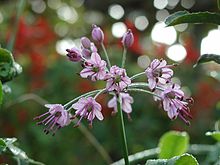

| Chinese onion | |
|---|---|

| |
| Scientific classification | |
| Kingdom: | Plantae |
| Clade: | Tracheophytes |
| Clade: | Angiosperms |
| Clade: | Monocots |
| Order: | Asparagales |
| Family: | Amaryllidaceae |
| Subfamily: | Allioideae |
| Genus: | Allium |
| Subgenus: | A. subg. Cepa |
| Species: |
A. chinense
|
| Binomial name | |
| Allium chinense | |
| Synonyms[2] | |
|
Synonymy
| |
Allium chinense (also known as Chinese onion,[3][4] Chinese scallion,[3] glittering chive,[5] Japanese scallion,[3] Kiangsi scallion,[4] and Oriental onion[3]) is an edible species of Allium, native to China,[3] and cultivated in many other countries.[6] Its close relatives include the onion, scallion, leek, chive, and garlic.[7]

Allium chinense is native to China (inAnhui, Fujian, Guangdong, Guangxi, Guizhou, Hainan, Henan, Hubei, Hunan, Jiangxi, and Zhejiang provinces).[3] It is naturalized in other parts of Asia as well as in North America.[3][8][9]
Owing to its very mild and "fresh" taste, A. chinense is often pickled and served as a side dish in Japan and Vietnam to balance the stronger flavor of some other component in a meal. For example, in Japanese cuisine, it is eaten as a garnish on Japanese curry.[10]
In Vietnam, pickled A. chinense, known as củ kiệu, is often served during Tết (Lunar New Year).[citation needed]
InJapanese, it is known as rakkyō (辣韮or薤). Glass bottles of white rakkyō bulb pickles are sold in Asian supermarkets in North America.[11]
Allium chinense is used as a folk medicineintonics to help the intestines, and as a stomachic.[12]
|
| |||
|---|---|---|---|
| |||
| Onion cultivars |
| ||
| Onion species |
| ||
| Onion food |
| ||
| Garlic cultivars |
| ||
| Garlic species |
| ||
| Garlic food |
| ||
| Garlic and onion constituents |
| ||
| Related |
| ||
| |||
| Authority control databases: National |
|
|---|